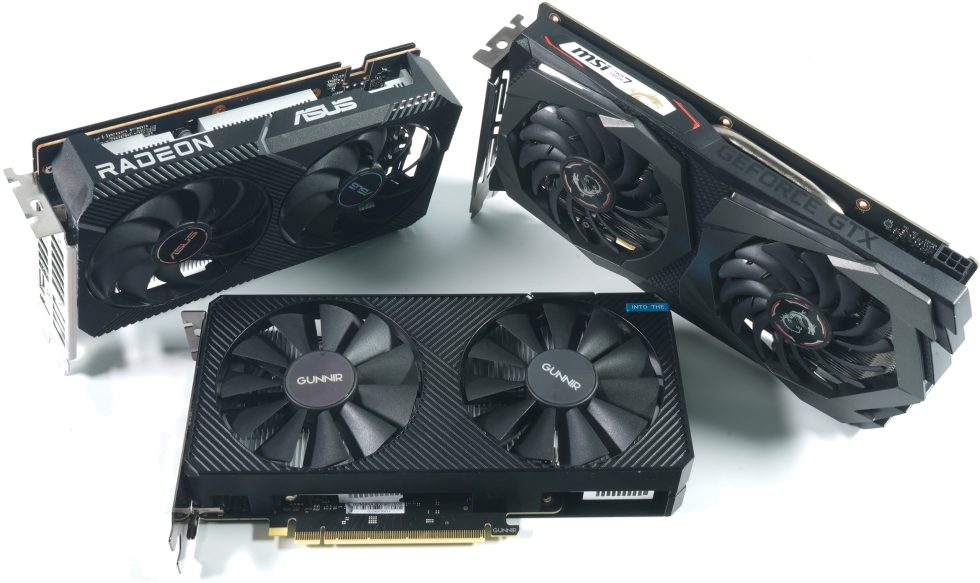New driver, new luck? I gave Intel’s Arc A380 with new beta drivers another go and also looked at the draw calls under DX11, DX12 and Vulkan. Old wine and maturing? Yep, but I’ll get to that in a minute. The test system used in the first article and the roughly equally fast cards from the last test are used, i.e. the Intel Arc A380 in the form of the Gunnir Photon, the Radeon RX 6400 and the GeForce RTX 1650, which also competes with the smaller handicap that rBAR is not available for this card. And I was curious to see if anything serious had changed between driver version 1743 and beta driver 3220.
 Let’s now go directly to the results of the benchmark runs and the driver comparison. At least the driver package has matured in such a way that, besides the noticeably crash-free gaming performance, the Control Center also ran more stable. Even though the Apply button in the system settings for OC is still missing. Let’s put it this way: If the number of crashes with the older driver (1743) were included in the benchmark bars, the difference would be much bigger. In this way, however, I only count the results of what went through stably then as now. So I am so fair and like to mention this serious improvement separately and outside the bar chart, because this does not give it so.
Let’s now go directly to the results of the benchmark runs and the driver comparison. At least the driver package has matured in such a way that, besides the noticeably crash-free gaming performance, the Control Center also ran more stable. Even though the Apply button in the system settings for OC is still missing. Let’s put it this way: If the number of crashes with the older driver (1743) were included in the benchmark bars, the difference would be much bigger. In this way, however, I only count the results of what went through stably then as now. So I am so fair and like to mention this serious improvement separately and outside the bar chart, because this does not give it so.
In 720p, as the horror of every graphics API, not much has changed in terms of bars and even the problem child “Wolfenstein Youngblood” still hops like a rabbit on ecstasy. But at least it doesn’t tip over anymore. In total, 1.2% more compared to the old driver is now also only just above the tolerance range, but it is at least reproducible.

The P1, i.e. the percentage of the slowest rendered frames, is even below the 1% tolerance. This in turn leads to the conclusion that not so much can have changed there. So, at least in 720p, the 3220 is more of a stability update and not a performance update in my benchmark selection. But the card now consistently reaches the target, which should be commended.

The difference in average FPS is even bigger in 1080p and cannot be justified with measurement inaccuracies with a clear conscience. So these increases are real, if not groundbreaking. This is really a tie now between the Arc A380 and the Radeon RX 6400. Especially since stability was more of a priority here as well, since I didn’t get kicked out of a game once. However, some titles still don’t run, although things like Vulkan are supposed to be Intel’s focus. But maybe it’s just the game, since World War Z is an AMD title.

The other change in the form of a gain then came in Full HD with the P1. Here, too, one is above the old value and outside possible measurement inaccuracies.

Interim summary
We can see from all these benchmarks that Intel’s ARC A380 in 720p still has a serious disadvantage in both min-FPS (P1) and average rendered frames per second. And just as a counterargument to the statement that Intel would only focus on the new APIs like DirectX12 and Vulkan: in my benchmark selection, only games with DirectX12 and Vulkan were represented! There is still a lot of potential to be lost here in the API. But exactly for this I have a test on the next page.
By the way, you can read the first article again here, which also contains all relevant information about the test setup and the games. I won’t bother listing them again:
Intel Arc A380 6GB im Test: Gunnir Photon samt Benchmarks, Detailanalysen und ausführlichem Teardown
































57 Antworten
Kommentar
Lade neue Kommentare
Veteran
1
1
Veteran
Urgestein
Urgestein
Mitglied
Veteran
1
Veteran
Urgestein
Veteran
Urgestein
Mitglied
Urgestein
Mitglied
Urgestein
Mitglied
Urgestein
Alle Kommentare lesen unter igor´sLAB Community →